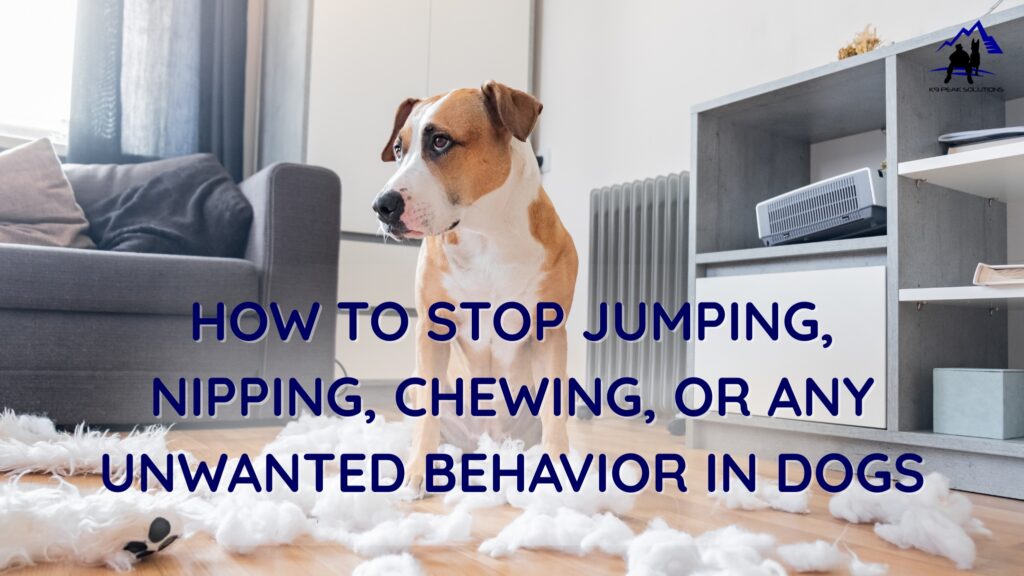
As a dog owner, one of the most common challenges you’ll face is managing unwanted behaviors like jumping, nipping, chewing, and general rambunctiousness. These behaviors, while often harmless, can quickly escalate into larger issues if not addressed early on. Whether you’re dealing with a hyperactive puppy who doesn’t know boundaries or an adult dog with deeply ingrained habits, it’s crucial to implement effective strategies to correct these behaviors and restore peace in your household.
Why Are Dogs Behaving This Way?
Before diving into the training solutions, it’s important to understand why these behaviors happen in the first place. Dogs may jump, nip, or chew due to excitement, boredom, stress, or even a lack of proper training. For instance, a dog who jumps on guests might be expressing excitement or seeking attention, while a dog who chews furniture could be trying to relieve stress or satisfy a natural urge to chew. However, without correction, these behaviors can become problematic.
In this chapter, we break down some simple but effective methods to address these common behaviors and help create a calmer, more controlled dog.
Key Training Tips:
1. Using Correction Methods:
- Towel Method: A towel, rolled tightly and secured with a rubber band, can be used as a gentle yet firm way to correct your dog’s actions. When your dog jumps on you or exhibits another unwanted behavior, use the towel to create a firm correction. This method should not hurt the dog, but the sudden change will catch their attention and help them associate the unwanted behavior with an unpleasant experience.
- Spray Bottle Method: Another method discussed is using a spray bottle filled with water. The trainer applies a quick spray to the dog’s face when they jump, nip, or chew. The surprise of the spray is unpleasant enough to deter the dog from repeating the behavior. Always be sure that the spray is not harmful and used in moderation.
These methods aim to redirect your dog’s attention and break their focus from the unwanted behavior. It’s important that these corrections are paired with positive reinforcement to encourage good behavior.
2. Consistency is Key:
Just as with any training technique, consistency is the foundation of success. Repetition is crucial to helping your dog understand what is expected of them. When a dog repeats an undesirable action and no correction is applied, it reinforces the behavior. On the other hand, if a correction is applied every time the behavior occurs, your dog will begin to associate that behavior with an unpleasant outcome.
For example, if your dog jumps up on guests and no consequence follows, they’ll continue to jump because they aren’t associating the behavior with a negative consequence. But if every time they jump, they experience a correction (like the towel or spray), they’ll learn over time that jumping leads to something unpleasant.
Make sure everyone in the household follows the same rules and corrections so that your dog can consistently learn which behaviors are acceptable and which are not.
3. Establishing Boundaries:
The trainer in the video emphasizes the importance of setting boundaries. Just like how a classroom teacher enforces rules to maintain order, you need to become the authority figure your dog respects. Dogs thrive on structure, and they need to understand what is expected of them.
When training a dog, it’s vital that you’re firm but calm. If your dog jumps on you, immediately apply a correction and don’t allow the behavior to escalate. You should aim to maintain your calmness throughout the training to ensure that your dog sees you as the consistent, confident leader.
When you establish clear boundaries, your dog will learn what is acceptable and what isn’t. For example, if you’re teaching your dog not to jump on guests, ensure that this rule is consistently enforced. Whenever your dog jumps, immediately stop the behavior using your chosen method (towel, spray bottle, etc.). Over time, your dog will stop jumping altogether.
4. Reinforcing Positive Behavior:
Correcting unwanted behavior is only part of the equation. You must also focus on reinforcing positive behaviors to encourage your dog to make better choices. For example, if your dog greets someone without jumping, praise them immediately. Use treats, toys, or verbal praise to reward calm behavior. This positive reinforcement will help your dog understand that they will receive something good when they behave appropriately.
Training is all about balance: consistent correction for undesirable behavior and positive reinforcement for desirable behavior.
Additional Tips:
- Redirect Attention: If your dog is chewing on something inappropriate, offer them an alternative toy. This redirection helps them learn what’s okay to chew on and what’s not.
- Exercise: Sometimes, unwanted behaviors like jumping or nipping can be a result of excess energy. Make sure your dog is getting enough physical and mental stimulation throughout the day to burn off that energy.
- Patience: Behavior changes take time, so be patient with your dog. Some dogs may learn faster than others, and that’s perfectly normal. Stay consistent and patient, and you’ll see results.
Conclusion:
Training a dog to stop unwanted behaviors like jumping, nipping, and chewing takes time and consistency, but the results are well worth the effort. By using simple correction methods, establishing clear boundaries, and reinforcing positive behaviors, you’ll help your dog become a calmer, more obedient companion. Keep in mind that every dog is different, so experiment with different techniques to see what works best for your pup.



